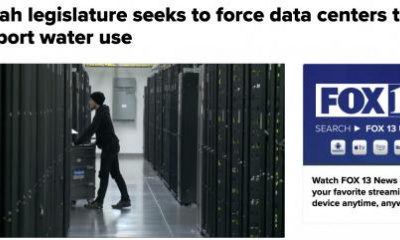SALT LAKE CITY — Rep. Joel Briscoe, D-Salt Lake City, admits he has a sentimental reason behind his desire to save the Great Salt Lake.
He has fond memories of traveling across the causeway toward the Fielding Garr Ranch on Antelope Island, where his daughter was married in 2009. The lake hovered around 4,195 feet elevation at that time, about 6 feet above where levels are currently, as the lake remains near its lowest levels on record.
"I want to see water, not a lakebed, to see where my daughter was married," he said.
So as state and local leaders look for solutions to bring water back to the lake, Briscoe is tossing in a new idea. The lawmaker is proposing HB286, which would redirect close to $60 million in "existing annual tax collections" every year to a fund to help restore the Great Salt Lake over the next five years, or nearly $300 million over that span.
He explains that the funds currently go toward the Water Infrastructure Restricted Account, which sets aside funding for Lake Powell Pipeline and Bear River Development, two projects that haven't started yet. The $179 million amassed since the fund was created in 2015 wouldn't be touched, and the pot for both projects would increase again beginning in 2028.
The new funds, he adds, would help the Utah Division of Forestry, Fire and State Lands in their efforts to restore lake levels.
Setting a new goal benchmark for success
Briscoe's bill is one of a few new ideas for preserving the Great Salt Lake proposed this week. Sen. Nate Blouin, D-Salt Lake City, also on Wednesday unveiled details of a resolution that seeks to set 4,198 feet elevation as the goal for "saving" the Great Salt Lake.
That level, the freshman senator explains, is considered the lake's "minimum healthy levels," based on research conducted by the Utah Department of Natural Resources.
"We've set up a great framework that's going to get water back to the lake but we haven't yet established a target that gives us an overarching goal to work toward," Blouin said. "We know (the lake) is an economic and environmental anchor in the region. ... We're all counting on the lake in one way or another."
The Great Salt Lake's levels have already raised by a foot as a result of storms over the past few weeks; however, it remains almost 9 feet below that target objective at the moment.
There is no time frame listed for reaching that goal in the proposed resolution, though it still is subject to change. Blouin said he would like to see Utah reach that goal "as soon as possible."
Both bills are backed by the Utah Rivers Council, a nonprofit that has pushed for increased water conservation efforts across the state.
"We, as Utahns, have been given the responsibility to steward for the rest of America ... the largest remaining wetland ecosystem in the American West," said Zach Frankel, the organization's executive director. "It is a big responsibility for us to protect."
State of the Great Salt Lake
Utah's drought and the health of the Great Salt Lake are clearly on the minds of state and local leaders at the start of 2023. Utah Gov. Spencer Cox, Salt Lake County Mayor Jenny Wilson and Salt Lake City Mayor Erin Mendenhall have all referenced the topic in their annual addresses about the current state of the community this month.
That's because the lake's downfall exposes the areas surrounding the lake to its toxic dust plumes among other potential issues. The lake also contributes to more than $1.3 billion and 7,700 jobs in local economic benefits annually.
In her address Tuesday night, Mendenhall called on the Salt Lake City Council to adopt a more thorough review of all water used by the city to figure out inefficiencies and implement a temporary drought surcharge to major water consumers to discourage water waste. The surcharge would go up in cost as drought conditions worsen and decrease when drought conditions improve.
She also authorized the Salt Lake City Public Utilities Department to file the water rights paperwork needed to send nearly 13 billion gallons of reclamation water directly to the Great Salt Lake every year, though that figure only represents about one-thirtieth of the annual deficit the lake faces at the moment.
"The disappearance of the Great Salt Lake is not something that's just happening to us, it's something that is happening largely because of us and because of climate change," she said. "Utahns are not victims or passive observers. We must take responsibility for our choices and take bold action now."
But the Salt Lake Valley, she adds, only impacts about 9% of the total water that dumps into the lake. That's why other governments are also working on ways to reduce water, including the state as a whole.
Last year, the state approved a few bills related to water conservation, including $40 million in new funds to create the Great Salt Lake Water Trust.
Cox, during his State of the State address last week, called on the state Legislature to approve hundreds of millions of dollars in more water conservation and agriculture optimization funding, as well as adopt policies that would reduce the state's per capita water consumption, too. The governor also continued to ask Utahns of all faiths to continue to pray for drought relief, while these policies are considered.
"I ask again that we join together to ask for relief from this drought all while knowing that, here on Earth, God's work must truly be our own," he said. "I believe that God can fill the lake but, if not, then we must."









